In a serious SHTF situation, you may be forced to bug out of a homestead or dwelling. Or maybe you have been caught out unexpectedly whilst out and about, and you have no access to your survival gear at home or in the car.
Further still, maybe you’re bunkered down and start to run out of some survival items.
Whichever scenario you find yourself in, it’s good to know that there are numerous common objects that have many uses that you may not have thought about.
Mouthwash
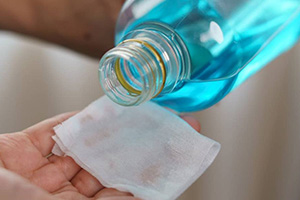 Mouthwash that has at least 25% alcohol can be used in first aid as it is both antibacterial and antiseptic. Prevent infection by applying mouthwash on a wound to clean it thoroughly.
Mouthwash that has at least 25% alcohol can be used in first aid as it is both antibacterial and antiseptic. Prevent infection by applying mouthwash on a wound to clean it thoroughly.
If left untreated, infections can spread causing sepsis which is fatal if not treated.
Mouthwash can also be used as a disinfectant to sterilize needles or cooking equipment.
⇒ Why You Should Always Keep Some Listerine in Your Medicine Cabinet
If head lice or ticks are a problem, it can help to kill them for you.
Ticks may well cause Lyme Disease which in the early stages will cause fever and fatigue, something you don’t need if you have to keep moving.
Dental Floss
Dental floss is so handy being lightweight and complete with its own cutter.
It can be used for tasks where something needs to be bound to something else because it is very strong. If you don’t have a fishing line, it can be used for that too.
It can substitute for thread if you have run out of it or it is not available.
Pantyhose
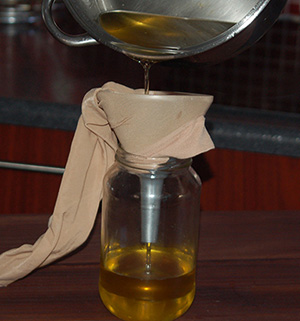 Pantyhose makes a great water filter because of its fine mesh that is able to catch contaminants. It can also be used as a fishing net or a dust mask.
Pantyhose makes a great water filter because of its fine mesh that is able to catch contaminants. It can also be used as a fishing net or a dust mask.
To prevent blisters, put them on first before your socks. Blisters can be very painful especially if you have to keep going.
Pantyhose is also a defense against ticks, chiggers and leeches. They can be used as a vessel for carrying things you have gathered such as fruits.
⇒ 20 Foods You Can Keep Longer In Pantyhose
In case of injury, they can be used as a tourniquet, sling or to secure a bandage.
Bandana
More than just a fashion item, a bandana has many uses and has the advantage of being cheap, light and easy to carry.
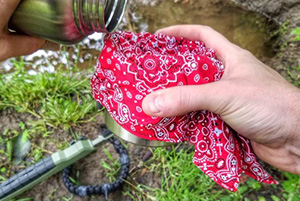
It can obviously protect your head from the sun, but can also be used as a face mask to help you breathe in dusty conditions.
It makes a great sling or tourniquet when needed. The bright neon colors may also help to attract the attention of rescuers should you need rescuing.
Socks
We all own at least one pair of socks, but who would have thought of its uses.
Apart from keeping your feet warm, they can act as something to collect water in and also to filter it of debris and bugs.
⇒ This Bug Will Kill Most Americans During The Next Crisis
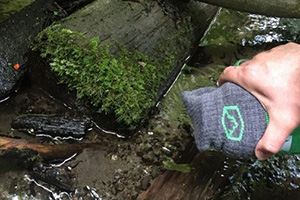
This filtered water should be boiled or left to sit, so that further sediment can sink to the bottom of the container.
Add a few drops of iodine, sit for 30 minutes and then it should be safe to drink. It’s even possible, if nothing else is available, to use the lint from cotton socks as tinder.
Vodka or Any Alcohol with a Minimum Proof of 80%
This type of alcohol can be used as a cleaning agent for wounds or any equipment that needs sterilizing.
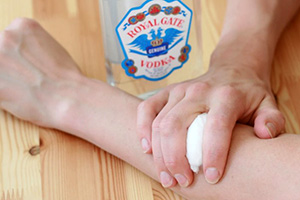 This will help to prevent infection of wounds and make sure that implements such as needles or razor blades are sterile should you need to perform some simple medical procedures.
This will help to prevent infection of wounds and make sure that implements such as needles or razor blades are sterile should you need to perform some simple medical procedures.
Vodka is good as a gargle for throat troubles and can help to suppress coughs.
When applied on the skin, it can act as a repellent for flies and also to give relief from insect bites. Lastly, it can also be used as a fire starter when you need to get a fire going.
Cans
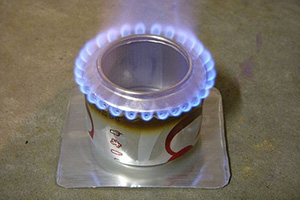 Aluminum soda cans substitute as water containers and can also be cut and fashioned into fishing hooks.
Aluminum soda cans substitute as water containers and can also be cut and fashioned into fishing hooks.
The concave bottom of the can be polished with toothpaste to act like a mirror to kindle a fire.
Related: Uses For Soda Cans
Empty food steel cans can also be utilized as small stoves or used to make arrowheads and other weapons.
Large, Heavy Duty Garbage Bags
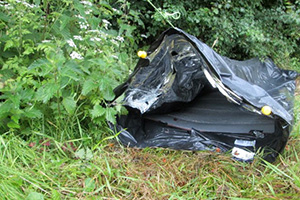 These types of bags have many uses to keep you warm and dry.
These types of bags have many uses to keep you warm and dry.
Many people use them as a poncho after cutting out a hole for the head and then slipping it on. Using one or more bags filled with dry leaves or newspaper, they can substitute as a mattress or sleeping bag.
Garbage bags can also be used to collect rain water by placing them in a hole.
If the full length of the bag is cut on either side, the resulting plastic sheet can be used as part of a shelter.
Steel Wool
The need for kindling a fire will include cooking, boiling water for drinking, keeping warm and maybe signaling for help.
There are various ways of starting a fire including using steel wool and a 9 volt or AA battery. Simply roll the steel wool into a tube shape.
Carefully pull out the ends on either side of the tube. Place each end on the negative and positive terminals of the battery, in that order. Very soon the steel wool will begin to glow.
Add your tinder onto it to kindle the flame. This is a very fast method and works great even when there are damp conditions.
Just remember, you may find yourself in a survival situation where you need a Plan B. All the items listed above may be improvised for survival.
With a little know-how, these weird items may become indispensable to you and those around you. Just because they are ordinary items doesn’t mean they can’t be used in extraordinary ways.

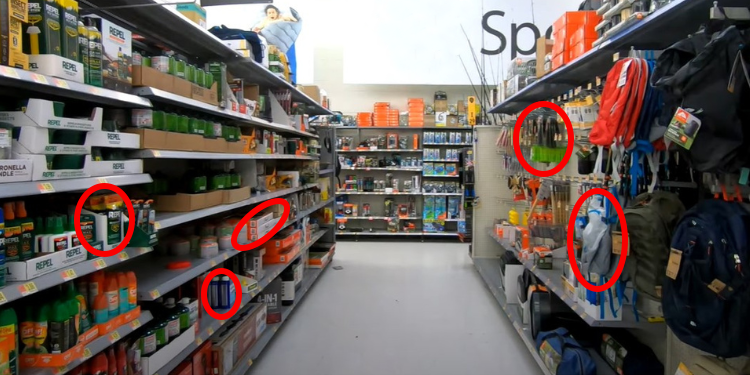













Not sure I would want to wreck my socks but it’s a good thought.
Boot technology has improved so its less common unless you got shitty boots for the panty hose deal.
Might as well add some tea candles
My weirdest things in my prep, is a tampon, Gun; shot plugs, pop it in and instant blood clot.
Then safety pins, > wound closure.
Then Horse tail hair, very strong, > wound closure.
Then a Thimble, for sewing.
Then a very, very, sharp piece of Flint stone.
Just some of the things that I think that I might need one day, while running from the evil people…
O’ Ya, forgot tea candles… and hot glue sticks.
This article brings the mind to think of thing that normally would not cross your mind. I like it…
Please look into why tampons are not a good idea for gunshot wounds and such. Tampons are not made to hold a lot of blood and my to think you can or should use one is not a good idea.
Yes, I am well awear that a tampon is not a good thing to use and yes, they do not hold a lot of blood, BUT the reason for them is to ONLY stop the blood from coming out, until you can get some help.
Used for that reason, so you won’t bleed out. This is not a long-term Solution… Just a patch job.
If you have nothing, A tampon will work best.
I also recommend having a metal flea/lice comb, stainless steel scissors, tweezers, nail clippers, and anything else you use that you can find in stainless steel, and paracord.
Used tampons – tea bags for VAMPIRES! LOL
They are very dry and can be used as tinder if necessary.
Oh boy yeah tampons don’t plug a gunshots
Why is this site considered dangerous?
Because we know a few things in this world that are not taught anymore for a reason. Ignorance is profitable to the higher ups. Maybe read the Handmaid’s Tale by Margaret Atwood.
A good use for pantyhose is as an emergency fan belt to keep the coolant flowing. As for lint being used for tinder, my wife just collects it from the dryer and shoves it into used paper towel rolls of TP rolls…we have a life-time supply, no matter how many times we go camping, and just put a little Vaseline on them and the burn well enough to start a good fire.
in regard to using a trash bag for water – the better bag manufacturers do a spray coat on the plastic interiors during the line processing – odor and a pesticide – I wouldn’t wash up using that water much less drink it …..
Illini, Thanks for pointing out that the bags are coated. That explains why the 55 gal. bags are easier to open than some others.
“Vodka or Any Alcohol with a Minimum Proof of 80%”
80% alcohol is 160 proof.
I think they mean 40% alcohol which is 80 proof. That will be the most common!!!
Most vodka is 40% alcohol (80 proof). Be careful of rum because many rums, especially flavored rums, are only 21% alcohol (42 proof).
I buy vodka by the case (I am an herbalist and use it to extract medicine from plants).
And if you look at the top, they recommend mouthwash that has “25 percent” alcohol…makes you wonder how many people wrote this article since it has a few contradictions.
And yet the mouthwash only has 25% alcohol in it…
it might have some contradictions, but if it gets folks thinking outside the box it has served it’s purpose. A large part of survival is mindset. Folks learned to do without during the great depression or make do. A good portion of the rest of the world still does.
Distilled white vinegar has been proven to kill bacteria also. At least you wouldn’t be so apt to drink it. Lol
The thymol in most mouthwashes would make you regret drinking it as it will mess up your stomach. It’s the major disinfectant in mouthwash and is listed as a pesticide by the FDA. It’s fine for washing your mouth out but not for getting a buzz.
They put that in there so prisoners cannot drink it and get drunk in prison.
An alcohol solution has to be at least 60% strength to kill germs. That is why 80 proof is useless as an antiseptic, it has to be 151 proof like Everclear. Alcohol has a reputation for medicinal uses because it is an effective and available way to extract active ingredients from herbs. Read the label on a bottle of amber Listerine mouthwash, alcohol is listed as an inactive ingredient, the active ingredients are extracts of thyme, eucalyptus, and peppermint. The ingredients are in a strong concentration to act as the denaturing agent the idiot government requires to be added to ethyl alcohol so we don’t drink it untaxed, the herbal extracts make it an excellent rinse for oral hygiene. Probably not a good choice for disinfecting wounds..
Medicinal use of alcohol is thousands of years old. An extract of walnut shells made with vodka was on this site recently. Another example would be the use of quinine extract made with alcohol and added to seltzer water by the Brits in India, this was the tonic water they mixed with Gin to prevent malaria.
70% alcohol is antiseptic but should NEVER be used to treat even minor wounds, it kills healthy tissue, delays healing making infection more likely, and increases scarring.
Using a tampon to treat a gunshot wound is also very bad, almost guaranteeing infection by pushing bacteria deep into the body. If you are fleeing the Hell Hounds and can’t call 911, the article’s suggestion of socks and bandannas can be used to make a pressure dressing.
Arse, are you a medical practitioner? What’s your perspective on “hand sanitizers”? Do they work or not, and why or why not? How about alcohol swabs used to wipe the skin when given an injection, how good are they? What about all these disinfectant wipes and sprays that have been propagandized to “kill COVID virus”? Do they work or not, and why or why not? If you run out of Isopropyl Alcohol, then SOAKING things in even a 40% solution does help sanitize then – why do you think microbes, including molds, do not survive in 80 proof liquor like vodka, why is that? You have to work with what’s available at the time you need it.
I am a retired gardener. Hand sanitizers are bad for the skin, soap and water is more effective, a good handwashing removes 99% of bacteria. Pre-injection wiping with 70% alcohol is standard practice. For more invasive procedures it would be best to paint the area with Povidone. 40% alcohol is a growth inhibitor, you’d probably find bacteria in a bottle of Vodka, I can’t scientifically verify this because we empty a handle of Vodka around here in 3 or 4 days. Lesser concentrations of alcohol help sterilize a surface by removing some of the bacteria and killing more through rapid dehydration, but the needle or other implements can’t be considered sterile. In the pre-antibiotic world people died horribly in great numbers from staph and strep infections, the post SHTF world is going be, not just a bear, but a blanking Grizzly.
Arse, I’ll trust the medical practitioners in my family over anything you post. They work ER’s, OR’s, even the COVID Wards when they were “in fashion”, and sterilization is paramount in their careers. I’ll tell you what, when SHTF and you decide washing everything in soap and water is preferable for sanitization over soaking even in lower percentages of an alcohol solution, then go right ahead and gamble. I’ll wash my hands, arms, scrub the nails/cuticles and the instruments in soap and water, rinse extremely well in absolutely sanitized potable water, then soak in vodka for a while if I had no better options. As far as all those “disinfectant” products I mentioned? Most people have no clue how much and for how long you have to have those chemicals in contact with microbes before they actually work well. Hand sanitizer? Sharp Hospital disseminated information that the hand sanitizer offered in most public places has to have an extremely thick layer and remain a gooey “gel” on the skin for several minutes to have any real beneficial sanitizing effect. Same for those “wipes” for shopping carts, etc,. most need an extended exposure to work well, and most people miss a lot of what they think they are wiping off, leaving a patchwork of semi-clean and infected areas. Want to test? Use a good quality UV light to see what shows up AFTER you think you disinfected.
Now I did agree that hand washing is paramount, also true that after a medical practitioner scrubs up they put on sterile gloves. American hospitals wage a mighty war on hospital caused infections, right now they have reduced the rate to 1 in 25 incare patients. This is across the system, some are better, some worse. Anybody involved in the health care system with a serious health problem needs an advocate to protect them from the Drs and nurses, the majority of whom are ignorant and arrogant and should be stealing money on Wall St instead of putting their patients in jeopardy. 1 in 5 hospital deaths are from infection, and medical error is one of the leading causes of death in the U.S. We train Drs. to become more stupid over time. Trauma medicine, ICU, we are the best in the world because war is our number one industry, the rest of the health care system is a shambles.
You should wash out every wound. THEN apply some sort of bandage.
Bleeding out and you die within minutes.
Bacterial infection you live long enough to get somewhere to treat it.
something a lot of people don’t realize anymore is simple things like a splinter that goes in deep, gets broken off and not dug out, may fester and even cause “blood poisoning”, which can be fatal if you don’t have the supplies to cut/clean it out and sanitize.
I’ve used my knife to cut out deeply imbedded splinters, even fishhooks, and always made sure to properly care for and sanitize the wounds when I was able. Yea, it hurts, but not as much as a deep infection that may eventually kill you.
AP,
I am glad that you mentioned all different types of disinfectants. Good job pointing out that healthy tissue can be damaged to the point of delaying healing of the wound if too strong of a solution is used for that situation. Each one has a purpose in different situations. You pointed out reading the label. That is something all of us should do more often. Medical personnel administer medications and treatments but rarely have time enough to sit and read the informational inserts that come with the product. It is very advantageous for any consumer to read that insert. I know of at least one instance where a nurse was reading an insert for a product being used on a patient she was caring for. She pointed out an aspect of the instructions to the attending doctor, that he was not aware of. The end result was that hospital policy was changed from that day on. A point that is not often mentioned is that the disinfectants have to be in contact with the surface for a time period to actually kill off the bugs. If a person in need of help is looking for it from someone who has been trained using “universal precautions”, be aware that those methods were designed to be “universal” so that the staff would not offend a sensitive and guilty portion of our society. “Universal precautions” used in many medical facilities does not do a good job of disease prevention in many situations.
I know a woman who used pantyhose once to make a fan belt when hers broke! It worked to get her going again.
There are numerous sited devoted to bandanas, they are extremely useful (a few):
Signal (also see signal mirror)
Neck Gaiter for cold weather
Tourniquet (But for Snake Bites use a Sawyer Extractor)
Pot Holder
Collecting Wild Edibles
Sunblock for neck
Sling (first-aid – also see medical kits for you BOB)
Sling (as in David and Goliath)
Sling (for a staff )
Cordage (strips or as is)
Washcloth/Towel (Bathe out of a Collapsible Bucket)
Sweatband
Waist pack/pouch
Hobo Pack
Padding a hotspot
Cleaning Patches for Firearm
Bullet Patches for Muzzleloader
Gun Wipe Cloth (with oil)
Toilet Paper
Mark a Trail
Dish Rag
Napkin
Eye patch
Pre-water (like Coffee Filters)
Clean Glasses and other lens
Ear Muffs
Bind a stone and toss a line over a limb
Dust Mask (in Urban Survival)
Wet and wear for Hot Weather
Sneezing
First aid bandage
Ice pack when snow and ice are available
Snow goggles
Lash poles
Lash a tripod
Make a dip net
Use as a wind gauge
Use as a press to squeeze water from saturated materials
A glove to pick up dirty items
A tool lanyard
Collect morning dew
Patching material for gear repair
Make char cloth
Make a fly fishing lure
An automatic signaling flag for traps
A muzzle
like your list except for the sawyer extractor for snake bites. Do work in hospital E.R.’s and trying to ‘suck out the snake venom’ doesn’t work and if you make cuts in the wound to help get it out (remember the old boy scout snake bite kits) will probable make it even worse. Probable won’t hurt but most likely won’t help either. Just my comment.
Agree. I’m an Aussie farmer and we are constantly training and re training snake bite first aid.
Splint/immobilise the bite area, then apply a pressure bandage (not a tourniquet tight! You don’t want to cause a rush of venom later when it’s removed) the length of the limb up and down to slow blood flow (but not cut it off) and reduce lymphatic drainage. Carry the person out and get to hospital asap. (Rural Australia doesn’t have a ready supply of ambulances always, we’d drive into town ourselves around here.)
Identification is nice, but don’t stress it. Most hospitals stock a dose or two of ‘generic anti venom’ in Australia that covers all the main beasties. It’s rare to die of snake bite here now if you do all this.
Using twine tie each of the four corners to a weight such as a 3/4 inch nut, throw it up in the air, makes a cool toy parachute for the kids.
Wish they would stop with the mouse tracking. Very annoying.
Warning: you have to “join” bevs vip safe haven to see what this person is selling.
Claude, if you’re going to censor your site and no longer allow the “Manage Subscription” functions, at lease monitor and BLOCK all the IP addresses (not the email addresses, the IP addresses, especially if you can trace back to the servers) that keep posting crap ass sales pitches.
I began thinking that the TAMPON treatment for gunshot wounds made sense… Being one of those that demand confirmation on topics I don’t completely understand, (probably due to my scientific background and training), I spent some hours researching the internet, talking to some authorities, e.g. my friends and acquaintances in the field of emergency medicine and others with some experience in the subject.
I found this simple paragraph generally conveys the essence of most replies:
“A search of peer-reviewed medical literature will fail to provide you with any data whatsoever on tampon use. This is likely, because no physician or researcher would recommend such a dangerous practice or suggest something so inferior to products that are battle tested with thousands of hours of research and hundreds of lives saved.”
Andrew Fisher, U.S. Army Physician Assistant
I did have at least one person that reccomended using a sanitary pad under a tightly wrapped elastic bandage as an improvised pressure dressing adding that a true dressing would be a better alternative…
Karl, I would wonder if the manufacturing process for some tampons is cleaner than others or uses better products than others. Just as our face masks were sometimes made in little grass huts and processed on the floor, tampon manufacturing processes most likely vary too. A great product used in some blood stopping assemblages is chitosan. It is made from the the shell of crustaceans. For a time, it was sold as a diet pill. Back then, it was quite inexpensive so I purchased some as I had heard of it’s blood stopping qualities. One day, I cut the sole of my bare foot quite badly. It bled profusely enough that there was no point in putting on any disinfectant. I opened two capsules of the chitosan and poured the contents onto a 4″x4″ gauze pad. I placed it on the wound. The blood mixed with the chitosan and created a rubbery disc over the wound. A couple of days later (or more), I was in the shower and peeled off the rubbery disc that was sealed onto my skin by the adhesive nature of the chitosan. The wound still needed healing so I bandaged it with fresh 4×4’s and such. The interesting aspect of the wound was that there was zero redness around the wound at any point and it all healed very nicely.
I can’t comment on tampons elsewhere in the world, but tampons in Australia are required to meet specific quality requirements set out by the TGA. It’s actually reasonably expensive and complicated to get TGA approval, and thus only serious manufacturers make them.
I still place some weight to the tampon argument with the following caveats:
– Know your tampons – obviously I’d be buying TGA approved Aussie ones, so they aren’t allowed to have lint release, must be chemical free (ish), and sterile (so as not to cause Toxic Shock Symdrome). Choose one of the ‘no perfume’ and similar ones. The chemical perfume and other loads in them can be quite high.
– Use only if there’s no better tool around
– Know that they are designed actually for a small volume of blood and act as a tamponade (expand when fill/widen) to plug a much larger hole than a .22 bullet would make (and thus might damage surrounding tissues complicating healing over time, for very small blood management, and yes, a sanitary pad and pressure bandage can cope with much much more).
– Should only be left in for a few hours tops, or there’s a risk of toxic shock/infection.
– Are a conveniently packaged sealed little lump of cotton wool, on a string, with an outer wrapper that stops it linting out. Think those limits through.
– Are probably wildly tradeable in almost any emergency situation, and take up a small amount of space in your kit.
– make great fire starters.
Bass Pro sells first aid camping equipment that has a gauze bandage that has a blood coagulant impregnated into the cloth. It works much better than a tampon.